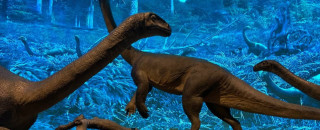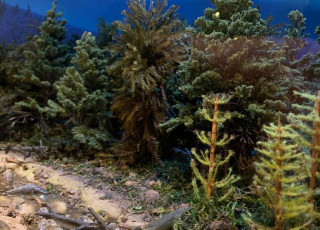Polar DinoFest: Nate Smith
By Riley Black
From our present moment in time, Antarctica might seem like a monolith of ice, rock, and freezing shores. But the stone of Earth's southernmost landmass tells many different stories. Year by year, and expedition by expedition, paleontologists have been learning more about the species that thrived on the continent - and how those organisms relate to those found elsewhere around the world.
Some of the most spectacular finds in Antarctica are of fossil vertebrates, from tusked, pig-like protomammals to dinosaurs with strange headgear. And it's the stories of these creatures that have fascinated Natural History Museum of Los Angeles paleontologist Nate Smith. One of the stars of the Polar Dinosaurs exhibit, Smith has spent a great deal of time in the field and the lab decoding what these hard-won fossils mean for the history of life on Earth.
Even though about 98 percent of Antarctica is covered in ice, Smith says, the relatively small area of exposed rock is just the right type and age to yield some amazing fossils. Paleontologists have found everything from sharks and armored fish that swam in ancient waters over 359 million years ago to ancient birds that flew over the ancient Antarctic peninsula 66 million years ago. Some of the most stupendous discoveries, though, have come from Triassic and Jurassic rocks between 250 and 200 million years old.
While the first vertebrate fossils from Antarctica were found in 1967, the initial inspiration for scientists wasn't necessarily finding new species. If anything, researchers who visited the continent through the 60s, 70s, and 80s were focused on trying to understand how the species found in Antarctica compare to those found in other places. Experts were curious about biostratigraphy, or in which rock layers certain species are found, and the science of biogeography that maps where on Earth species are found at any given time. The fact that the Triassic protomammal Lystrosaurut. was found in both Antarctica and South Africa, for example, was a critical piece of evidence in confirming continental drift.
But paleontologists were finding more than familiar faces. The more experts dug in, the more they realized that some of the animals preserved in the rocks of Antartcia were not just like those found in rocks of the same age elsewhere. The carnivorous dinosaur Cryolophosaurus, for example, was unexpectedly unique, and other new dinosaur species are currently under study. Finds like these opened up new questions to experts. "How are they related to other species? How did they gorw? Was their physiology unique? What were their sensory systems like?", Smith wonders.
As much as has been uncovered so far, though, there is still so much more to be found. "We're still missing fossil representatives from important time periods in Antarctica's history," Smith says. Not to mention there's a lot of ground to cover. "Antarctica is, and was, huge!", Smith notes, with many of the big finds so far coming from a relatively small area. The fossil material that makes the backbone of the Antarctic Dinosaurs exhibit, for example, all comes from a single site that were excavated over three expeditions. Other sites certainly hold more fossils and will keep paleontologists busy for years to come. "There's probably more waiting for us not just on that mountain-side," Smith says, "but in the same rock unit all around the Beardmore Glacier!"
Click Here to Explore More of NHMU's Polar DinoFest
Riley Black is the author of Skeleton Keys, My Beloved Brontosaurus, Prehistoric Predators, and a science writer for the Natural History Museum of Utah, a part of the University of Utah in Salt Lake City. Our mission is to illuminate the natural world and the place of humans within it. In addition to housing outstanding exhibits for the public, NHMU is a research museum. Learn more.


